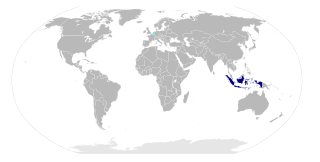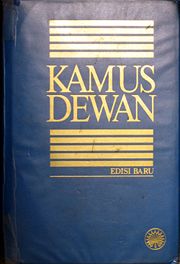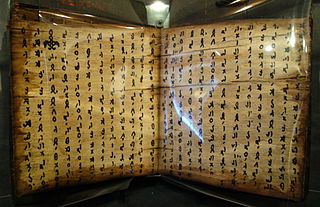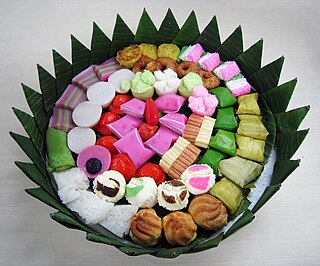Related Research Articles

Indonesian is the official language of Indonesia. It is a standardized variety of Malay, an Austronesian language that has been used as a lingua franca in the multilingual Indonesian archipelago for centuries. Indonesia is the fourth most populous nation in the world, with over 270 million inhabitants—of which the majority speak Indonesian, which makes it one of the more widely spoken languages in the world.

Malay is an Austronesian language officially spoken in Indonesia, Brunei, Malaysia and Singapore and unofficially spoken in East Timor and parts of Thailand. It is spoken by 290 million people across the Malay world.
In addition to its classical and literary form, Malay had various regional dialects established after the rise of the Srivijaya empire in Sumatra, Indonesia. Also, Malay spread through interethnic contact and trade across the Malay archipelago as far as the Philippines. That contact resulted in a lingua franca that was called Bazaar Malay or low Malay and in Malay Melayu Pasar. It is generally believed that Bazaar Malay was a pidgin, influenced by contact among Malay, Hokkien, Portuguese, and Dutch traders.
The Malaysian language or Malaysian Malay, is the name regularly applied to the standardized form of Malay language used in Malaysia. Constitutionally, however, the official language of Malaysia is stated as "Malay", but the term "Malaysian" or Bahasa Malaysia is used on official contexts from time to time. Malaysian is standardized from the Johore-Riau dialect of Malay. It is spoken by much of the Malaysian population, although most learn a vernacular form of Malay or another native language first. Malay is a compulsory subject in primary and secondary schools.
Malay and Indonesian are two standardised varieties of the Malay language, used in Malaysia and Indonesia, respectively. Both varieties are generally mutually intelligible, yet there are noticeable differences in spelling, grammar, pronunciation and vocabulary, as well as the predominant source of loanwords. The differences can range from those mutually unintelligible with one another, to those having a closer familial resemblance. The regionalised and localised varieties of Malay can become a catalyst for intercultural conflict, especially in higher education.

The Indonesian Wikipedia is the edition of Wikipedia in the Indonesian language. The Indonesian Wikipedia is the fifth-fastest-growing Wikipedia in an Asian language after the Japanese, Chinese, Korean, and Turkish language Wikipedias. It ranks 22nd in terms of depth among Wikipedias. Its first article was written on 30 May 2003, yet its Main Page was created six months later on 29 November 2003.
Keling or Kling is a word used in parts of Southeast Asia to denote a person originating from the Indian subcontinent. This includes both those from India and overseas Indians. It is also an offensive noun to be used in this current era towards the Indians. In modern colloquial usage it is commonly not capitalised. The term is used in the Malay Archipelago — specifically Malaysia, Indonesia, Singapore and Brunei — but cognates exist in neighbouring countries as well. Although the early definition was neutral and linked to the historical Kalinga kingdom of Eastern India,
A mukim is a type of administrative division used in Brunei, Indonesia, Malaysia and Singapore. The word mukim is a loanword in English. However, it was also originally a loanword in Malay from the Arabic word: مقيم. The closest English translation for mukim is township.

Malay was first used in the first millennia known as Old Malay, a part of the Austronesian language family. Over a period of two millennia, Malay has undergone various stages of development that derived from different layers of foreign influences through international trade, religious expansion, colonisation and developments of new socio-political trends. The oldest form of Malay is descended from the Proto-Malayo-Polynesian language spoken by the earliest Austronesian settlers in Southeast Asia. This form would later evolve into Old Malay when Indian cultures and religions began penetrating the region, most probably using the Kawi and Rencong scripts, some linguistic researchers say. Old Malay contained some terms that exist today, but are unintelligible to modern speakers, while the modern language is already largely recognisable in written Classical Malay of 1303 CE.

Kamus Dewan is a Malay language dictionary compiled by Teuku Iskandar and published by Dewan Bahasa dan Pustaka.

Mandailing or Mandailing Batak is an Austronesian language spoken in Indonesia, the northern island of Sumatra. It is spoken mainly in Mandailing Natal Regency, North Padang Lawas Regency, Padang Lawas Regency, and eastern parts of Labuhan Batu Regency, North Labuhan Batu Regency, South Labuhan Batu Regency and northwestern parts of Riau Province. It is written using the Latin script but historically used Batak script.

Sembah is an insular Southeast Asian greeting and gesture as a way of demonstrating respect and reverence. While performing the sembah, the person clasped their palms together solemnly in a prayer-like fashion called suhun or susuhun in Javanese; or menyusun jari sepuluh in Malay, and placed them in front of the chest, and moving the combined palms up to the chin, or all the way up until the thumbs touching the tip of the nose, while bowing slightly. Any of these two forms are made depending on the status of the person greeted.
Kei is an Austronesian language spoken in a small region of the Moluccas, a province of Indonesia.

Saeroen was an Indonesian journalist and screenwriter. Born in Yogyakarta, he became a journalist after a time working at a railway station. By the mid-1930s he had established the daily Pemandangan with Oene Djunaedi and was writing editorials with the pen name Kampret. When the paper was dissolved, Saeroen drifted into the film industry as a writer, making his debut with Albert Balink's Terang Boelan (1937). Much of his later life was spent working with several minor publications.
Suwawa is a Philippine language spoken in North Sulawesi (Celebes), Indonesia. It is also known as Bonda, Bone, Bunda, Bune, Suvava, and Toewawa.

Indonesian-Ukrainian dictionary by Mykhailo Izhyk is the first lexicographical work of Indonesian language in Ukrainian linguistics. It was released in 2013 by the publishing house "Chetverta Hvylia" with the financial support of the Embassy of the Republic Indonesia in Ukraine.

Jajan pasar refers to traditional Javanese cakes sold in the Javanese markets.
Béka Melayu, Cakap Melayu or Lidah Melayu is a linguistic purism of Malay language based on the Austronesian language group, especially the Malayic branches. This project is newly created by native cyberspace users on the Internet. It is also less known as Melayu Jati or Melayu Tulen, which means "pure Malay". Among the most significant foreign contributors to Malay vocabulary are English, Arabic, Sanskrit, Persian, Hokkien, and Tamil while Dutch is most spotted in Indonesian.

Tarawangsa is a traditional Sundanese musical instrument from West Java, Indonesia, in the form of a stringed instrument that has two strings made of steel or iron wire. Tarawangsa is an ensemble of chordophones of two musical instruments. One is called tarawangsa itself, played by swiping and the other is called jentreng played by picking. The art of Tarawangsa is performed in the Ngalaksa ceremony, which is a ceremony for abundant harvests. The ceremony in the traditional agrarian society of the Sundanese is always identified with the figure of Nyai Sri Pohaci or Nyi Pohaci Sanghyang Dangdayang Asri or Dewi Asri or Dewi Sri as the Sundanese goddess of rice.
References
- 1 2 3 4 "Sejarah Kamus Besar Bahasa Indonesia". Badan Pengembangan dan Pembinaan Bahasa. Retrieved 28 December 2021.
- 1 2 3 van Dam, Nikolaos (15 February 2009). "A sophistication unfolds in a new dictionary". The Jakarta Post. Retrieved 23 September 2020.
- ↑ Sugiharto, Setiono (4 April 2009). "'KBBI': Praise, critique from a language user". The Jakarta Post . Retrieved 23 September 2020.